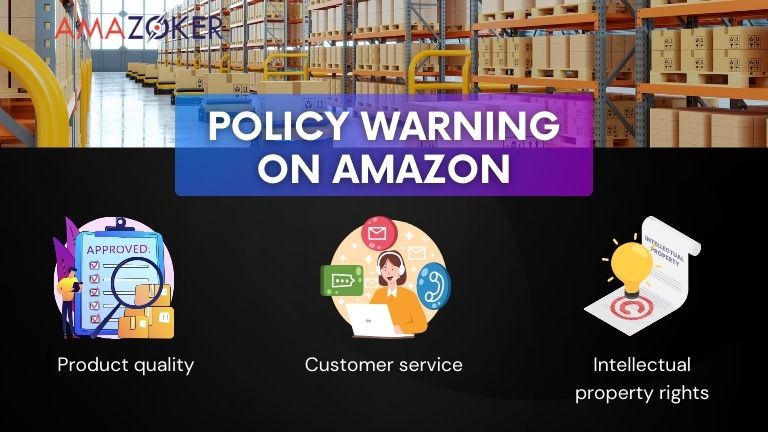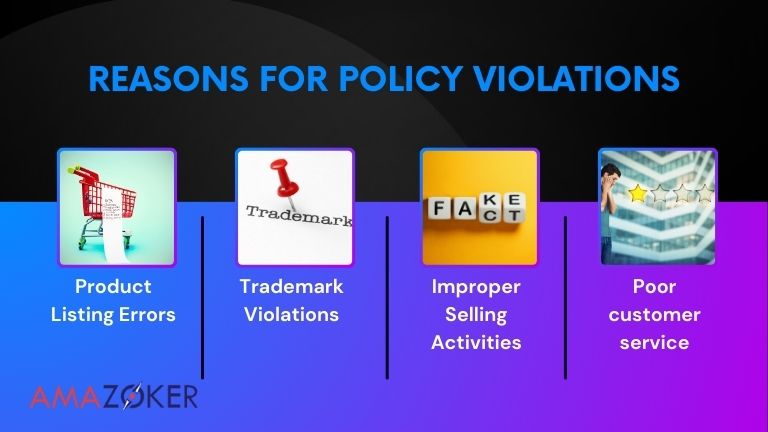As an Amazon seller, receiving a policy violation warning can be a stressful and confusing experience. These warnings are issued by Amazon when a seller’s account or listing is found to be in violation of their policies. Any violations can lead to warnings, suspensions, or even account termination. Therefore, understanding how Amazon policy violation warnings work and how to handle them effectively is essential.
Table of Contents
What is a Policy Warning on Amazon?
A policy warning on Amazon is a notification sent to sellers when their listings or actions on the platform have been found to be in violation of Amazon’s policies. These policies cover a wide range of areas including product quality, customer service, intellectual property rights, and more. Amazon has strict guidelines in place to ensure a positive shopping experience for customers and to maintain the integrity of their marketplace.

Amazon Policies encompass a broad spectrum of areas
When an Amazon listing policy violation occurs, Amazon will send a warning to the seller’s account with details about the violation and steps to take to resolve it. These warnings can also be viewed in the Performance Notifications section of the seller’s account dashboard. It is important to note that these warnings are not to be taken lightly as they can have serious consequences if not addressed promptly.
Read more: NAVIGATING AMAZON LISTING DEACTIVATION
What to Do When Receiving an Amazon Policy Violation Warning
Receiving an Amazon policy violation warning can be overwhelming, but it is important to remain calm and take immediate action. Here are the steps you should follow when receiving a policy warning.
Read the Notification Carefully and Understand the Reason for the Violation
The first step is to carefully read the notification and understand the reason for the violation. Amazon will provide specific details about the policy that was violated and the actions that need to be taken to resolve it. It is crucial to fully understand the violation in order to effectively address it.
There are several common reasons for policy violations on Amazon, including:
- Product Listing Errors: This includes inaccurate descriptions, unclear or inappropriate images, and using incorrect keywords. These errors can mislead customers and create a negative shopping experience.
- Trademark Violations: Selling counterfeit or copyrighted products, or using another brand’s logo or trademark without permission, are serious offenses that can damage Amazon’s reputation and potentially lead to legal issues.
- Improper Selling Activities: Activities like price gouging, fake reviews, and spamming customers can disrupt the marketplace and erode customer trust. These practices can also give your business an unfair advantage over legitimate sellers.
- Poor customer service: This can include late shipments, high order defect rates, or negative feedback from customers.

Four common reasons for policy violations on Amazon
Address the Root Cause of the Violation
Once you have identified the reason for the violation, it is important to address the root cause. This may involve making changes to your product listings, improving your customer service processes, or discontinuing the sale of restricted products. It is crucial to take corrective action as soon as possible to prevent further violations and maintain a good standing with Amazon.
Here’s how you can tackle common issues:
- For Product Listing Errors: You’ll need to meticulously review and update your product descriptions to ensure they are accurate, complete, and informative. Replace any blurry or irrelevant product images with high-quality photos that clearly showcase the item. Finally, conduct a keyword audit and remove any inaccurate or misleading keywords that don’t accurately reflect your product.
- For Trademark Violations: Take immediate action by removing any infringing products from your listings. If you believe you were selling a legitimate product but received a violation in error, contact the trademark owner to see if you can obtain permission to sell it. In cases where permission isn’t obtainable, you’ll need to permanently remove the product from your inventory.
- For Improper Selling Activities: Regain compliance by adjusting your pricing strategies to be competitive and fair. Focus on encouraging genuine customer reviews by providing excellent customer service. Remember to strictly adhere to Amazon’s communication guidelines when interacting with customers to avoid any potential violations.
Submit a Plan of Action (POA) to Appeal the Violation
After addressing the root cause of the violation, the next step is to submit a Plan of Action (POA) to appeal the warning. A POA is a detailed document that outlines the steps you have taken to correct the issue and prevent it from happening again in the future. It is important to be honest and thorough in your POA and provide any supporting evidence or documentation to back up your claims. Here’s a breakdown on how to structure it:
- Introduction and Acknowledgement: First, start with a professional introduction. Briefly greet Amazon Seller Support, introduce yourself with your seller ID or store name, and acknowledge receipt of the warning.
- Root Cause Analysis: Next, delve into the root cause of the violation. Take ownership of the mistake – finger-pointing won’t help. Briefly explain what went wrong, but focus on identifying the core issue, not excuses.
- Corrective Actions Taken: Following this, showcase the actions you’ve already taken to fix the problem. For listing errors, detail how you revised descriptions, replaced images, and removed incorrect keywords. If it was a trademark violation, highlight the removal of infringing products and any communication with the trademark owner. For improper selling activities, explain how you adjusted your pricing and customer communication practices.
- Preventive Plan for the Future: Demonstrate your commitment to long-term compliance by outlining specific measures you’ll implement. This could involve increased product listing scrutiny, implementing trademark checks, or attending seller training on relevant policies.

Steps for creating a Plan of Action for appealing a violation
Remember, a well-crafted POA with a professional tone, clear explanations, and concrete actions will significantly increase your chances of successfully appealing an Amazon policy violation warning.
Amazon will review your POA and determine whether to reinstate your listing or account. It is important to note that this process can take several days or even weeks, so it is crucial to act promptly and provide all necessary information to support your appeal.
Seeking Guidance and Support
Navigating the complexities of Amazon policies and procedures can be daunting, especially for sellers facing policy violations for the first time. In such situations, reaching out to professional services like Amazoker can provide valuable guidance and support. Amazoker offers expertise in Amazon compliance issues, helping sellers understand their obligations, navigate appeals processes, and safeguard their businesses from potential risks.
Receiving Amazon policy violation warnings can be a stressful and challenging experience for sellers. However, by understanding what these warnings are, and how to address them, sellers can maintain a good standing with Amazon and continue to grow their business on the platform. It is important to always follow Amazon’s policies and guidelines to ensure a positive shopping experience for customers and to avoid any potential consequences.











